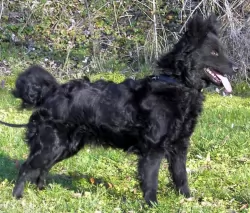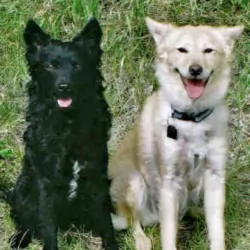 MyDogBreeds
MyDogBreedsMudi is originated from Hungary but Double-Nosed Andean Tiger Hound is originated from Bolivia. Mudi may grow 13 cm / 5 inches shorter than Double-Nosed Andean Tiger Hound. Mudi may weigh 15 kg / 33 pounds lesser than Double-Nosed Andean Tiger Hound. Both Mudi and Double-Nosed Andean Tiger Hound has almost same life span. Mudi may have more litter size than Double-Nosed Andean Tiger Hound. Mudi requires Moderate maintenance. But Double-Nosed Andean Tiger Hound requires Low maintenance
 Sometime between the 4th and 6th centuries, the Great Migration – a variety of dogs came to live in the Carpathian Mountains on the Great Hungarian Plain. This migration period brought sheepdogs and herders brought by shepherds. These dogs were of two sizes both small and large. The smaller ones were bred together – Pumi, Puli, and Mudi. Because of this, these breeds share the same history, with the Mundi being the oldest of them all.
Sometime between the 4th and 6th centuries, the Great Migration – a variety of dogs came to live in the Carpathian Mountains on the Great Hungarian Plain. This migration period brought sheepdogs and herders brought by shepherds. These dogs were of two sizes both small and large. The smaller ones were bred together – Pumi, Puli, and Mudi. Because of this, these breeds share the same history, with the Mundi being the oldest of them all.
The Mundi was finally separated from the other breeds about 1930 when Dr. Deszo Fenyesi began to breed them. It was in 1966 when the F.C.I. finally approved the standard for the breed. Still then as today, there were not many breeders developing the Mudi. They are working dogs – farm dogs – herders, guard dogs and ratters. He is also known as a tracker, with the majority of the breed living in Hungary.
As the Mudi was bred separately from the Pumi and the Puli, differences between the breeds became clear. Many Mudi are born with a stump or no tail at all. The Mudi is not a great dog for the first timer. He is stubborn, assertive and needs a lot of socialization and exercise. In 2004 breeders in the United States created the Mudi Club of America to preserve the breed and foster responsible ownership. This is a clever, active and keen breed, very loyal to his family but wary of strangers. The United Kennel Club recognized the breed in 2006.
In Hungary, these are still a breed of herding dogs capable of running 500 sheep at a time. They are versatile, courageous, intelligent and agile. They are great in obedience trials, agility, and flyball. In Finland and the United States, they also work as search and rescue dogs.
This is truly a rare breed of dog with his double nose. He hails from Bolivia.
Twentieth century reports of this rare feature include one report of a certain Percy Fawcett in 1913 already. This report received wide press coverage in 2006. There were photographs of this unique dog breed and they were distributed in the leading press outlets, with some people thinking that this was just a genetic abnormality.
However it soon proved that this wasn’t an abnormality but part of the breeds unique features, and these dogs can be seen around Bolivia and Trinidad.
It is believed that this dog is descended from the Pachon Navarro, a type of Pointer dog believed to have been brought to Central- and South America in the 16th century. Today, no kennel club recognizes the dog.
 This is a medium size dog with an almost square profile. They have erect ears on wedge-shaped heads. He is not a strong boned but medium boned. That square profile is based in large part on their very square stance. Their muzzle is about half the length of their head and they have what is considered a “dare devil” expression in their dark, almond-shaped eyes. The color of the eyes is important and must match with the color of the dog or the standard is not met.
This is a medium size dog with an almost square profile. They have erect ears on wedge-shaped heads. He is not a strong boned but medium boned. That square profile is based in large part on their very square stance. Their muzzle is about half the length of their head and they have what is considered a “dare devil” expression in their dark, almond-shaped eyes. The color of the eyes is important and must match with the color of the dog or the standard is not met.
Merle fur – brown, brown speckled, blue eyes.
Brown or gray-brown fur – Brown eyes
Gray fur – gray eyes
What is not acceptable is having yellow eyes and black fur; pink eyes and white fur. The lips, eye rims, and nose must all have the same pigmentation. This should be black in all but the brown and brown-grey dogs. These dogs have brown noses, eye rims, and lips. The tail can be almost anything from full to bob. All are considered to be natural lengths for a Mudi.
Their coat is self-cleaning and won’t mat. It is on the long side. In fact, a short, flat, smooth coat is a disqualification from the standard. The color of the coat ranges from white to brown to gray, gray-brown, merle, golden, cream and white. Very little markings of any kind are usual.
The Double-nosed Andean Tiger Hound is a medium to large sized pure bred dog known specifically for this unique feature – the double nostril divided by a skin and fur band.
He stands at roughly 48 – 60cm and weighs 20 – 29kg. The dog has floppy ears or semi-erect ears with short limbs and a long tail.The coat of the dog is short and silky and it can be brown and white or black, grey and white or he can be a mixture of several of these colors.
Even though the dog’s name - Andean Tiger Hound - might make people think it is similar in character to a tiger, it is actually a sweet natured dog with a gentle nature that loves being close to its human family.
It lives peacefully with children and pets in the home. It is a brave, alert dog who makes a good watchdog. He is an energetic dog and will require regular exercise such as long walks. As with all dogs he can benefit with training and socialization and being an intelligent breed, he is actually easy to train.
 Yes, they are great with children and love being a part of a large family or “pack”.
Yes, they are great with children and love being a part of a large family or “pack”.
They are extremely versatile and great at herding and guarding.
They are adaptable if you are. They don’t need to live in the country, but they need space to run and play.
They are highly intelligent but a little stubborn. Their ability to learn is high but you have to be the boss.
This medium sized dog with the double nose is unusual in that respect, but he is no different from most other dogs when it comes to making a wonderful pet.
Loving, loyal, gentle, easy to please, amicable and intelligent, the Double Nosed Andean Tiger Hound guarantees to make you an excellent pet as he has so many of the desired characteristics of a good friend.
 The Mudi does face several of the problems that medium to large dogs often face and some eye issues as well.
The Mudi does face several of the problems that medium to large dogs often face and some eye issues as well.
The Double nosed Andean Tiger Hound, with good care, can reach 12 to 15 years of age.
Every dog has common dog ailments to contend with and some of these your dog might be susceptible to are -
Atypical disease to look out for as your dog grows older. It can be heartbreaking to watch your bet battling to walk and battling to get up from lying down.
This is a disease with dogs that accounts for almost 50% of deaths in pets. It is a killer and you want to be looking out for drastic weight loss and lumps and get your pet to the vet.
This is a respiratory infection and it can be easily be passed from one dog to the next. Your dog will have a raspy cough and will be lethargic too.
This can cause weight loss in your pet and he can also have a swollen stomach and be lethargic.
Anything can cause your dog to have an allergy, whether it is fleas or ticks or even food. Common allergies can be treated by changing some of the things you believe could be aggravating your pet.
Remember that a healthy, balanced diet and good exercise are important for keeping your pet healthy and ensuring longevity.
 The Mudi needs a high quality, medium breed puppy dry food and should be fed 3 or 4 times a day for a total of 1 and ½ to 2 cups.
The Mudi needs a high quality, medium breed puppy dry food and should be fed 3 or 4 times a day for a total of 1 and ½ to 2 cups.
The adult should be fed at least twice a day with an adult medium breed high-quality dry dog food. Don’t overfeed as the breed can have a tendency toward obesity.
They have great stamina and agility.
This is a working dog and like most herding dogs, they need a job and a lot of activity. Long walks every day and either a large yard or visits to a dog park. Involve them in herding activities or Barn Hunt if you can. Playing is their way of working when they are not herding real animals. So, if you want this breed, be sure you have time for playing with them. They are great at agility, flyball, obedience, frisbee trials, tracking and of course herding
Feed your pet a quality diet – either from the top-range commercially manufactured foods or home-made food such as cooked rice, vegetables and chicken.
Steer well clear of over-feeding your pet as this can negatively affect your pet’s health in many ways.
Ensure your pet is always sheltered from the weather and that he has both sun and shade.
Your Double Nosed Andean Tiger Hound is an energetic dog and you want to walk him and make sure that he gets regular exercise to keep fit, lean and healthy.
Dogs are social creatures and to stick him in your back yard without any interaction with you is enough to make him ill and to take all the spirit out of him. Rather don’t get a pet.